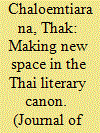|
|
|
Sort Order |
|
|
|
Items / Page
|
|
|
|
|
|
|
| Srl | Item |
| 1 |
ID:
091967


|
|
|
|
|
| Publication |
2009.
|
| Summary/Abstract |
Luang Wilat Pariwat's Khwam mai phayabat [The Non-Vendetta] published in 1915 under the pseudonym 'Khru Liam' has been acknowledged as the first full-length novel written by a Thai author in the Thai language. However, literary scholars have been ambivalent about its place in the Thai literary canon because it appears to have been written as a parody of Marie Corelli's Vendetta (1886), which was translated into the Thai language in 1901 with the title Khwam phayabat. Apparently, Khru Liam's Khwam mai phayabat was not a market success because it disappeared from the public eye until 1997 when a copy was found and reprinted in 2001. This article contends that Khwam mai phayabat is more than a parody or an imitation of a Western novel, that it is authentically Thai and is significant on several registers. First, the novel is part of a larger survival strategy to prevent Siam's colonization. Second, it warns against the negative influences of modernity and urbanization, especially on Thai women. Third, the novel celebrates Buddhist values, especially the teaching that forgiveness is the only way to stop the cycle of revenge. Khwam mai phayabat was written before its time. It criticized a Bangkok society that was rapidly modernizing with imported material goods and values from the West. Apparently, this was not attractive to the Thai readership, which preferred instead to read about adventures in Europe and in Africa. Khwam mai phayabat was followed by another novel, Nang Neramid [Divine Nymphs] by the same author, which was about the adventures of some Englishmen in Africa. Nang Neramid appeared in 1916, allowing the author to make up for his earlier financial losses.
|
|
|
|
|
|
|
|
|
|
|
|
|
|
|
|
| 2 |
ID:
077667


|
|
|
|
|
| Publication |
2007.
|
| Summary/Abstract |
Published for the one and only time in 1916, the little-known Thai novel Nang Neramid [Divine Nymphs] is the recently rediscovered work of Khru Liam (pseudonym Nai Samran). Author of Siam's first example of a full-length novel, Khwam Mai Phayabat [The Non-Vendetta], Khru Liam's fiction bears a close relationship to translated Victorian works popular among Thai readers of the time, such as Marie Corelli's Vendetta and Sir Henry Rider Haggard's She. This article explores the Siamese adoption and adaptation of Western literary sources to produce a Thai novel in close imitation of the Western form. Nang Neramid, penned shortly after the reprinting of Khru Liam's own translation of She (under the title Sao song phan pi), is an adventure story set in Egypt featuring English, Egyptian, Ethiopian, Negro and Arab characters. Masquerading as the translation of a Western novel, Nang Neramid's tale of adventure, intrigue, magic, warfare, romance, occult and the erotic is revealed only in its closing pages to be without English prototype. It follows explorations by a young English scholar, James Billford, of ancient ruins and caves that harbour the well preserved mummies of young women, brought to life by the interventions of a grand wizard. The nymphs become sexually irresistible to any male who touches them, and the novel includes descriptions of the erotic trysts that ensue. Khru Liam combines his portrayal of male sexual drives and female responsiveness in this novel with a study of Buddhist religious concepts and the occult, examining how sexuality can be conditioned by the objective and the subjective self.
|
|
|
|
|
|
|
|
|
|
|
|
|
|
|
|
| 3 |
ID:
089372


|
|
|
|
|
| Publication |
2009.
|
| Summary/Abstract |
The Thai literary canon identifies three novels published around 1929 as the first authentic Thai novels. This pronouncement elides the importance of novels published before that date. Because literary scholars focus their teaching, writing and research on novels defined by the canon, lesser-known works have been overlooked or ignored. The current Thai canon obfuscates literary transmission, in particular, the significance of pre-1929 compositions. In this essay, three novels - Mae Wan's Khwam phayabat (1902), Khru Liam's Khwam mai phayabat (1915) and Nang neramid (1916) - are selected to show that these early compositions represent important genres of novels that should be considered for the canon, even though they are seen as less than 'authentic' Thai. This paper examines the three novels through the lens of critical, translation and postcolonial theories. It is a study of vernacularisation, authenticity, hybridity, mimesis, and bi-culturalism.
|
|
|
|
|
|
|
|
|
|
|
|
|
|
|
|
| 4 |
ID:
096574


|
|
|
|
|
| Publication |
2009.
|
| Summary/Abstract |
The Thai literary canon identifies three novels published around 1929 as the first authentic Thai novels. This pronouncement elides the importance of novels published before that date. Because literary scholars focus their teaching, writing and research on novels defined by the canon, lesser-known works have been overlooked or ignored. The current Thai canon obfuscates literary transmission, in particular, the significance of pre-1929 compositions. In this essay, three novels - Mae Wan's Khwam phayabat (1902), Khru Liam's Khwam mai phayabat (1915) and Nang neramid (1916) - are selected to show that these early compositions represent important genres of novels that should be considered for the canon, even though they are seen as less than 'authentic' Thai. This paper examines the three novels through the lens of critical, translation and postcolonial theories. It is a study of vernacularisation, authenticity, hybridity, mimesis, and bi-culturalism.
|
|
|
|
|
|
|
|
|
|
|
|
|
|
|
|
|
|
|
|
|